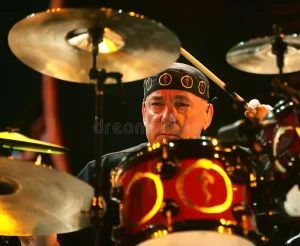Neil Peart (1952-2020)is considered to be one of the all-time greats of rock drumming and for many reasons.
Neil Peart overcame great personal tragedy in 1997 when his daughter, Selena, was killed in a car accident and within a year, his wife Jackie died from cancer. Neil abruptly left Rush and music. He spent the next few years traveling on his motorcycle all over North and Central America on a solitary journey to think about his life. Over time, with the support of his family and friends, Neil eventually returned to music and Rush. Upon his return, Neil explained that ” I started surrendering to drumming and exploring it in an organic way. At a certain point, I realized that I was telling my story on the drums. I was playing through every emotion that past two years had put me through. There were the angry parts, the sorrowful parts, and the traveling parts.”
While Neil Peart has always been known for his astonishing technique and virtuoso fills and solos, his playing matured to a new level on 2002’s Rush album Vapor Trails. In a Modern Drummer Magazine article, Neil stated that “my critical factualties have refined and developed to where I’m listening for a whole musical effect to come out of the technique, not the technique itself.”
To fully understand the musicianship of Neil Peart, we must see how he and his legendary band, Rush, evolved.
Rush (1968-present) formed in 1968 when guitarist Alex Lifeson met bassist/vocalist/keyboardist Geddy Lee and drummer John Rutsey. Inspired by Cream, Led Zeppelin, and The Jimi Hendrix Experience, Rush was manufactured in the “power trio” mold. The band spent their first five years playing blues-rock covers and a few originals in the bar scene in Toronto, Canada. With no early interest from any major record labels, Rush recorded and released their self-titled debut album Rush in 1974. A single from the album, “Working Man,” received local radio airplay and Rush was signed to Mercury Records. Before recording their second album, Rutsey left the band and Neil Peart auditioned and won the drumset chair.
1975’s Fly by Night saw the band move in a progressive rock direction. It was decided that Lifeson and Lee would do the songwriting. Peart would handle the lyrics, a good move considering that he was a writer and an avid reader of science fiction. Fly By Night featured the tune “Anthem.” It demonstrated the band’s ability to move easily from 4/4 to 7/8 passages that would become a trademark for Rush. 1975’s Caress of Steel saw Rush moving to longer compositions and lyrics about sword and sorcery images. The new punk era was ending the careers of many progressive rock bands, but Rush was able to survive. The Rush sound was powerful with Lifeson’s guitar distortion and shredding solos combined with heavy metal power, all displayed with a progressive rock sensibility.
Rush released a more commercial album, 1976’s 2112. It helped to build a wider audience. It also sparked the genre of progressive metal. 1977’s A Farewell to Kings yielded the Rush classics “Closer to the Heart,” and “Xanadu.” A strong progres- sive record on many levels, A Farewell to Kings gave Rush the balance of commercial success while maintaining their musical sense of adventure. 1978’s Hemispheres was their most ambitious work to date, yielding even more popular appeal. On this album, the complex composition “Cygnus X-1” took an entire album side and challenged the listener both musically and lyrically.
The 1980’s were a decade of change for Rush. Most progressive rock bands were either finished or focused on surviving in a world dominated by FM rock radio. Rush managed to create strong progressive material and achieve more commercial success. 1980’s Permanent Waves featured the hits “The Spirit of Radio” and “Freewill.” The band felt they needed to get back to a more focused songwriting format, a process that yielded the success of Permanent Waves. This would be a transition period for Rush, still very progressive but now moving in a somewhat more “radio friendly” direction.
1981’s Moving Pictures became Rush’s most popular album, reaching number four on the U.S. charts. It featured the hits “Tom Sawyer,” “YYZ,” and “Fly By Night.” “Tom Sawyer” was an example of Rush’s move to synth parts mixed with Lifeson’s metal guitar riffs.
The whole middle synthesizer part in 7/8 time started out as one of Geddy’s sound check keyboard riffs during the Permanent Waves tour. Geddy Lee’s distinctly high vocal sonorities further defined the Rush sound. Also, as recording technology kept improving, Rush was able to take advantage of increased multi-tracking, having access to forty-eight tracks (using ten tracks for the drums alone). All of a sudden, Rush was everywhere, on the radio and MTV, when Moving Pictures went to number three on the British charts and sold almost seven million copies.
